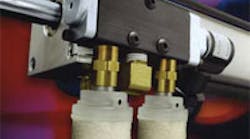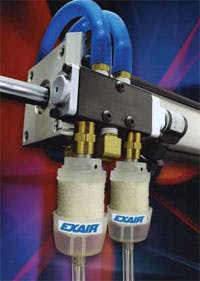Reclassifying mufflers from Exair Corp. Cincinnati, can be installed directly into the exhaust port of cylinders, valves, and other airpowered equipment to reduce work area noise and harmful oil mist. They are easy to retrofit to new and existing installations.
Installing mufflers such as these can provide a noise reduction to 35 dBA to help meet EU noise directive (86/188/EEC) and OSHA standard 29 CFR-1910.95. Wrap design of the removable element eliminates oil mist contamination of worker’s breathing air, keeping exposure well below the 4.32 ppm required by OSHA. Harmful open dead end pressure is also eliminated.
Each reclassifying muffler has a high air flow capacity to minimize backpressure restriction so as not to interfere with the operation of the cylinder, valve, or other air-powered device. A reservoir for oil to accumulate at the bottom can be drained by attaching a 14-in. tube. They are available in sizes from 18 to 1 in. NPT.
For more information, call (800) 903-9247 or click here.


